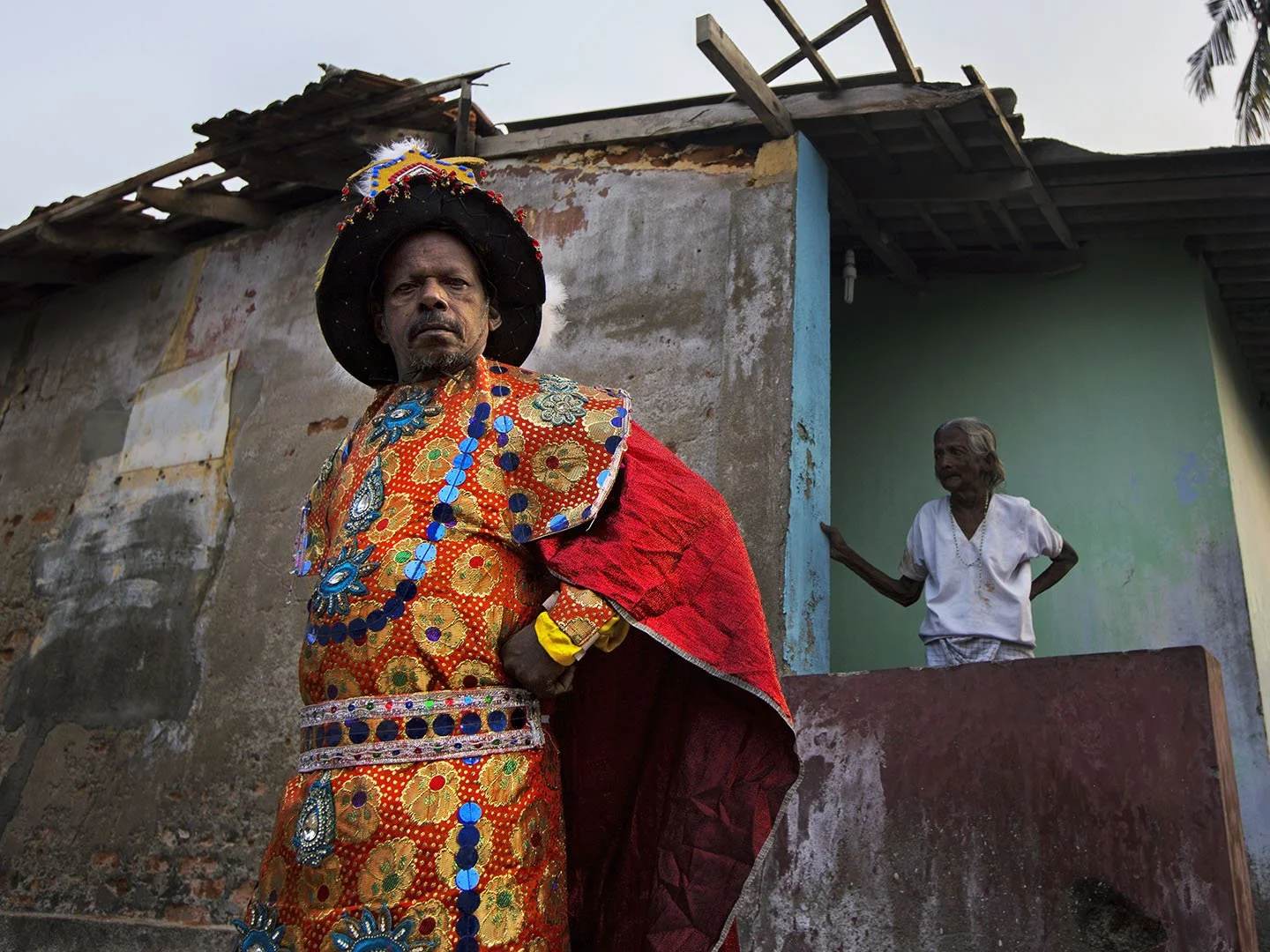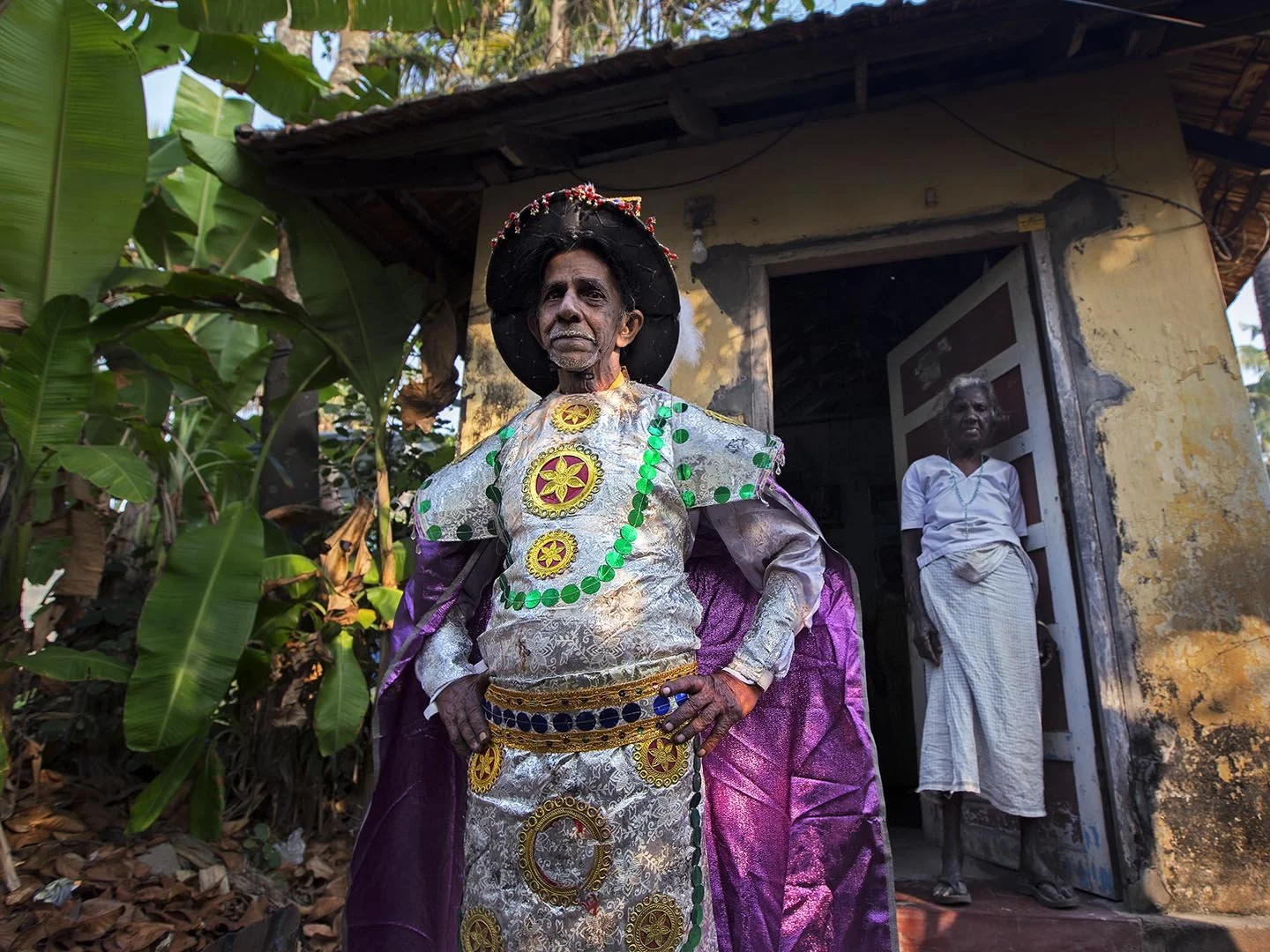Modesti Perdriolle
Rue Saint-Georges 27
1050 Bruxelles
https://www.modestiperdriolle.com/
Chavittu Nadakam : Storytellers of the seashore - K.R. Sunil (IN, 1975)
14 January - 28 February 2026
FR Living Contradictions est un travail d’ethno-photographie qui se concentre sur la vie quotidienne des interprètes du Caviṭṭunādakam, une combinaison danse-musique-drama dont la genèse remonte à la période de la domination portugaise dans le sud de l’Inde. Aujourd’hui, cet art de la performance se maintient sur un tronçon relativement limité de la côte du Kerala, principalement de Kodungallur (ancien port de Muziris) jusqu’à Kochi et Alappuzha. Cet art juxtapose la tradition martiale de l’ancien Kerala avec les traditions théâtrales et musicales de l’Europe des XVe et XVIe siècles dans un mélange singulier. Les mouvements du corps et les gestes présentent une ressemblance frappante avec de nombreuses pratiques performatives locales du sud de l’Inde, tandis que l’intrigue, la musique et la chorégraphie évoquent l’opéra européen. Les interprètes portent beaucoup de maquillage, des costumes vifs et des ornements, donnant ainsi aux personnages une apparence quasi-super-héroïque. Mais dans la vie réelle, appartenant pour la plupart aux communautés dalit et de pêcheurs converties au christianisme par les missionnaires coloniaux, ils ne jouissent d’aucun statut particulier. Néanmoins, ces artistes continuent de défendre l’art, qui est devenu indissociable de leur vie. Récemment, la montée des eaux et l’avancée de la mer – principalement causées par le changement climatique global – perturbent leur quotidien. Une communauté qui s’efforce de protéger un art menacé doit désormais lutter pour préserver son habitat.,Ce travail photographique s’intéresse de près à la vie quotidienne des interprètes et à leur effort incessant pour offrir un souffle de vie à l’art.
NL Living Contradictions is een ethno-fotografisch project dat zich richt op het dagelijks leven van de uitvoerders van het Caviṭṭunādakam, een combinatie van dans, muziek en drama waarvan de oorsprong teruggaat tot de Portugese overheersing in Zuid-India. Tegenwoordig wordt deze podiumkunst nog beoefend langs een relatief klein stuk van de Keralese kust, voornamelijk van Kodungallur (de voormalige haven van Muziris) tot Kochi en Alappuzha. Deze kunstvorm juxtaposeert de krijgstradities van het oude Kerala met de theatrale en muzikale tradities van 15e- en 16e-eeuws Europa in een unieke mix. De lichaamsbewegingen en gebaren vertonen opvallende gelijkenissen met vele lokale performancepraktijken in Zuid-India, terwijl het plot, de muziek en de choreografie doen denken aan Europees opera. De uitvoerders dragen veel make-up, kleurrijke kostuums en versieringen, waardoor de personages een bijna superheldachtige uitstraling krijgen. In het echte leven behoren de meesten echter tot Dalit-gemeenschappen en vissersgemeenschappen die door koloniale missionarissen tot het christendom zijn bekeerd, en genieten zij geen bijzondere status. Toch blijven deze kunstenaars hun kunst verdedigen, die onlosmakelijk met hun leven verbonden is. Recentelijk hebben stijgende wateren en de opmars van de zee — voornamelijk veroorzaakt door de wereldwijde klimaatverandering — hun dagelijks leven verstoord. Een gemeenschap die vecht om een bedreigde kunstvorm te behouden, moet nu ook strijden om haar leefomgeving te beschermen. Dit fotografische werk richt zich nauwgezet op het dagelijks leven van deze uitvoerders en hun onvermoeibare inspanning om hun kunst tot leven te brengen.
EN Living Contradictions is an ethno-photographic project focusing on the daily lives of performers of the Caviṭṭunādakam, a dance-music-drama hybrid whose origins date back to the period of Portuguese rule in southern India. Today, this performance art survives along a relatively small stretch of the Kerala coast, mainly from Kodungallur (the former port of Muziris) to Kochi and Alappuzha. This art form juxtaposes the martial traditions of ancient Kerala with the theatrical and musical traditions of 15th- and 16th-century Europe in a unique blend. The body movements and gestures bear a striking resemblance to many local performative practices of southern India, while the plot, music, and choreography evoke European opera. Performers wear elaborate makeup, vivid costumes and ornaments, giving the characters an almost superhero-like appearance. Yet in real life, most belong to Dalit and fishing communities converted to Christianity by colonial missionaries and enjoy no special status. Despite this, these artists continue to defend their art, which has become inseparable from their lives. Recently, rising waters and coastal encroachment — primarily caused by global climate change — have disrupted their daily existence. A community striving to protect a threatened art now also faces the struggle to preserve its habitat. This photographic work closely examines the daily life of these performers and their relentless effort to breathe life into their art.
Image : Storytellers of the Seashore - Courtesy of Modesti Perdriolle Gallery © KR Sunil
OPENING HOURS
Mon closed
Tue closed
Wed 2pm-6pm
Thu 2pm-6pm
Fri 2pm-6pm
Sat 11am-6pm
Sun closed
_
ADMISSION PRICE
Free admission




